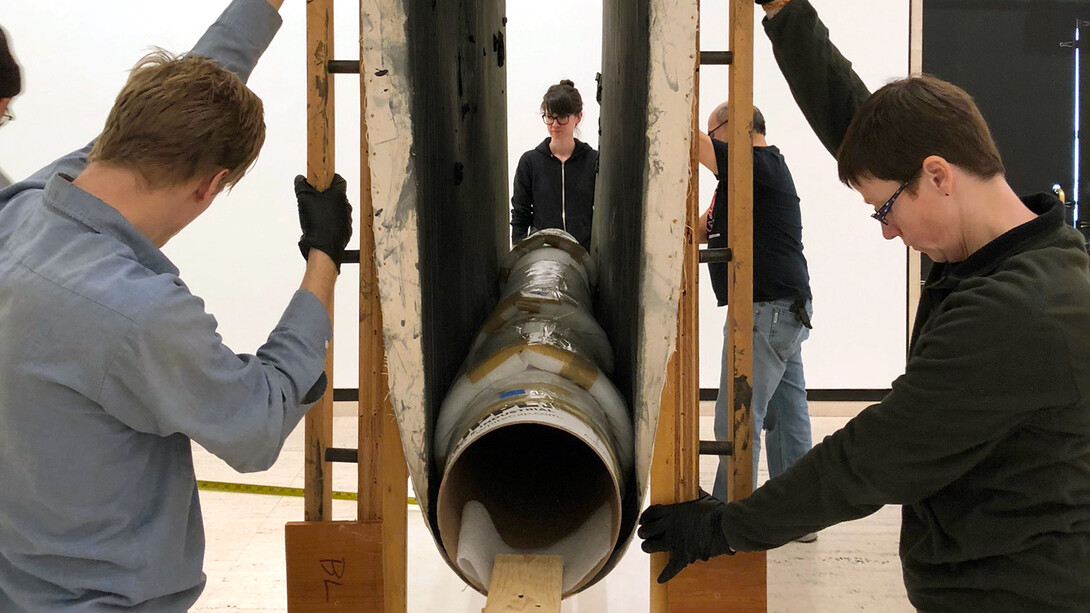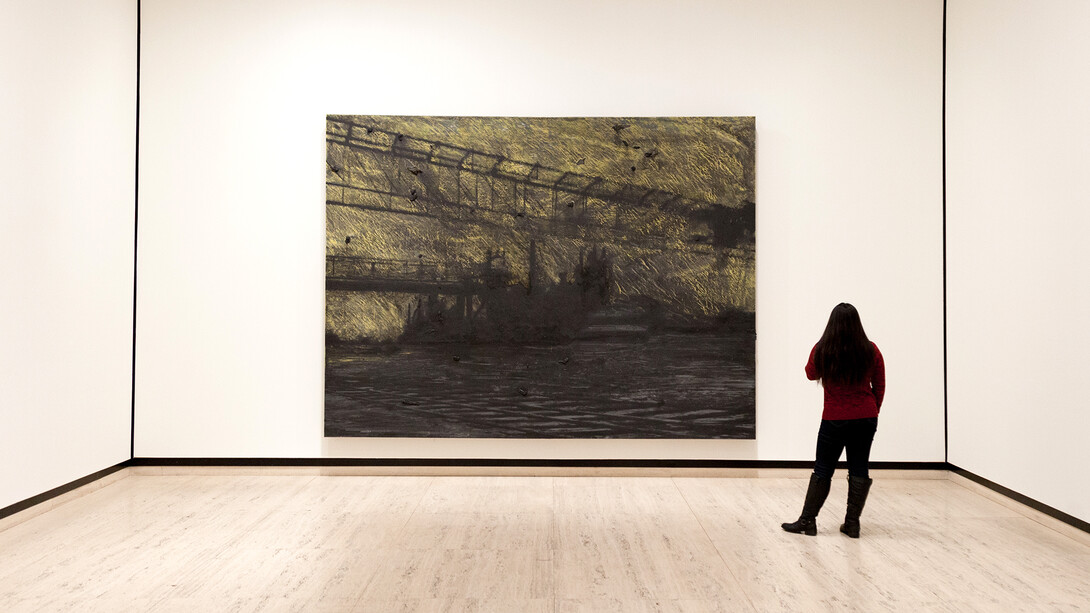
How do you get a very large painting into a museum when it is too big for the door?
Collections staff at the Sheldon Museum of Art faced that question with the arrival of “Dead Plant November 1 1988.” The painting is part of “Donald Sultan: The Disaster Paintings,” a touring exhibition organized by the Modern Art Museum of Fort Worth, Texas. The exhibition opens at Sheldon Jan. 26 and continues through May 13.
At 12 feet by 9 feet, the painting was simply too large to fit through the museum’s loading-dock door.
Working collaboratively, officials for the Modern Art Museum, which owns the painting, and Sheldon staff came up with a solution — to fold the artwork. Very carefully.
Museum staff sometimes develop creative solutions to move large or awkwardly shaped artworks in and out of the museum. Luckily, the act of folding a painting isn’t that unusual.
“It’s not something you want to do often,” said Brent Mitchell, a Modern Art Museum official who supervises artworks as they are moved from venue to venue for the touring exhibition. “It’s extra stress on the painting. It worked out very well, but I was nervous. Mistakes can cause damage or other problems with a work of art.”
When they were given the dimensions of the paintings and crates that would arrive for the Sultan exhibition, Sheldon Registrar Stacey Walsh and Preparator Delan Lonowski realized “Dead Plant” was going to be a challenge. They contacted Mitchell, who serves as the Modern Art Museum’s head of exhibition and collection management.
“The max for getting things through our door is 90 to 96 inches, depending upon whether it’s safe for the artwork to bring it in on an angle,” Walsh said.
While a homeowner might try to wedge a king-sized bed through a window, that was simply not a realistic option for the art museum. The expense to remove a window in the Philip Johnson-designed building, which is listed on the National Register of Historic Places, would have been prohibitively expensive.
“Dead Plant,” an abstract representation of an abandoned factory, is composed of latex paint and tar on canvas. The Modern’s head of installations recalled that when it was purchased in 1989, it arrived in a folded state. But it had not been folded in nearly 30 years.
“The Sheldon is the last stop of the tour,” Mitchell said. “It is the fifth venue and the only one on the tour that couldn’t accommodate the painting in its crate.”
Mitchell declined to reveal the financial value of “Dead Plant.”
“Our mindset is whether a painting is worth $100 million or $100,000, we try to treat everything with the same care,” he said “Paintings are unique and pretty much irreplaceable. We try to treat everything with the same level of professionalism and care.”
The painting is mounted on two sets of stretchers joined at the middle with five sets of metal mending plates. Stretchers are wooden frames used to mount and stretch the painting canvas.
Lonowski came up with a game plan: the painting would be delivered to the Sheldon’s off-site storage facility, where a wooden cradle would be built to support the painting after the mending plates were removed and to gently fold it inward.
The painting could not be folded so sharply that the painted surface touched itself. The tar in the painting is a bit sticky and could adhere to the opposing side — one reason it wasn’t a good idea to completely remove the canvas from its stretchers and roll it up for transport, which is sometimes done.
Lonowski wrapped a 12-inch-diameter cardboard tube in Dartek, a nonstick nylon film often used in art museums. The tube was placed along the center of the painting as its sides were folded up, to prevent the painting from creasing or sticking to itself.
It took at least four people to hold the painting, as Lonowski built the support structure. Once in its cradle, the painting was trucked to the Sheldon, where it fit easily through the loading dock door and into the gallery where it was mounted for display. In fact, the large painting probably was easier to mount on the wall for display than Sultan’s smaller paintings that are constructed in four separate panels that must be mounted precisely flush to one another, Mitchell said.
Walsh said occasionally Sheldon staff deal with artwork of large size or awkward shape that makes it difficult to move into the galleries. A Robert Motherwell painting exhibited in 2016 was too long for the freight elevator, so staff carefully carried it up the Sheldon’s grand staircase for exhibition. In 2009, one of the large canvases in “Dan Christensen: Forty Years of Painting,” organized by the Kemper Museum of Contemporary Art, had to be removed from its stretcher to be moved into the gallery space.
“It’s not super common, but we face it when it comes up,” Walsh said.








